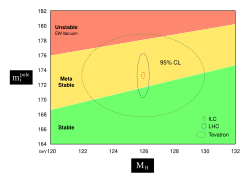| 本条目所属系列 |
| 物理宇宙学 |
|---|
宇宙的终极命运是物理宇宙学中一个主要的议题。许多科学理论都对宇宙的命运作出预测并成为竞争的对手,包括未来与时间是有限还是无限。
自从宇宙起源于大爆炸并经历暴胀的概念为大多数科学家接受之后[1],宇宙的终极命运就成为宇宙论可以探讨的问题,取决于物理上的性质:在宇宙中的质量/能量,它们的平均密度和膨胀速度。
脱颖而出的科学基础
理论

在阿尔伯特·爱因斯坦于1916年提出广义相对论之后,宇宙的终极命运在科学上成为能够探讨的问题,可以用广义相对论来描述有最大规模的宇宙尺度。广义相对论的方程有许多不同的解,每个解都意味着一种可能的宇宙终极命运。 亚历山大·弗里德曼在1922年就提出了一些如同乔治·勒梅特在1927年提出的解[2]。其中有一些宇宙最初是从奇点开始膨胀,基本上,这就是大爆炸。
观测
在1931年,爱德温·哈勃出版他研究的结论:根据他对遥远星系造父变星的观测,宇宙是膨胀的。此后,宇宙的开始和它可能的结束就成为科学研究的重要议题。
大爆炸和稳态理论
在1927年,乔治·勒梅特提出以后被称为大爆炸的宇宙起源理论[2]。在1948年,弗雷德·霍伊尔提出了反对的稳态理论,认为宇宙在统计上是稳定不变的,但是不断的有新物质被稳定的创造而扩大。这两个理论都有积极的赞同者,直到1965年阿诺·彭齐亚斯和罗伯特·威尔逊发现宇宙微波背景辐射,这是大爆炸理论预测的一个事实,并且是稳态理论所无法解释的。结果,大爆炸理论很快就成为宇宙起源最普遍被接受和持有的观点。
宇宙的形状

根据天文观测和宇宙学理论,可以对可观测宇宙未来的演化作出预言。均匀各向同性的宇宙的膨胀满足1930年代所提出的FLRW度规。根据这一方程(不考虑暗能量的时候),物质的引力会导致宇宙的膨胀减速。宇宙的最终命运决定于物质的多少:如果物质密度超过临界密度,宇宙的膨胀最后会停止,并逆转为收缩,最终形成与大爆炸相对的一个“大挤压”(英语:Big crunch);如果物质密度等于或低于临界密度,则宇宙会一直膨胀下去。另外,宇宙的几何形状也与密度有关: 如果密度大于临界密度,宇宙的几何应该是封闭的;如果密度等于临界密度,宇宙的几何是平直的;如果宇宙的密度小于临界密度,宇宙的几何是开放的。并且,宇宙的膨胀总是减速的。
然而,上述说法只考虑了物质质量之数量,而并未考虑暗能量的数值,即是只代表了ΩΛ=0而ΩM分别为不同数值的情况。若然ΩΛ也考虑在内的话,开放宇宙(曲率为负)即使Ω<0也可以到达大挤压,封闭宇宙(曲率为正)即使Ω>0也可以永远加速膨胀[3]。在ΛCDM模型成立之前提下,相关常数之最新观测值表示,宇宙曲率接近平坦,膨胀速度则在加速。
宇宙的稳定性

研究宇宙的本质与未来命运已经持续很多年了。描述宇宙的科学模型都会将宇宙的亚稳定性纳入考量,也就是说宇宙很可能拥有很长的寿命,但并不是完全稳定,空间某些区域可能在未来某个时刻被摧毁,因此倒塌成为一种更加稳定的真空态。[5]假若能够更准确地测出希格斯玻色子与顶夸克的质量、标准模型能够正确地描述粒子的物理行为甚至到普朗刻尺度的极端能量,则可以得知宇宙的现有真空态是否稳定,或仅仅只是长寿[6][7](有时这会被误解为“希格斯玻色子终结了宇宙”[9])。而质量大约在125 – 127 GeV值域内的希格斯玻色子似乎非常接近分割稳定区域与亚稳定区域的边界。[4]更明确的答案仍需等待更准确地测量顶夸克的极点质量(英语:Pole mass)。[4]
假若测量结果建议,宇宙的真空是一种伪真空,则这意味着当今宇宙的作用力、粒子、架构可能不再存在,在几十亿年之后,[10][注 1]可能会被另外一种宇宙(若它能成核)全盘替代。[注 2]准确测量顶夸克质量可能需要新一代高端精密的正负电子对撞机。[4]
参见
注释
参考文献
- ↑ Wollack, Edward J. Cosmology: The Study of the Universe. Universe 101: Big Bang Theory. NASA. 2010-12-10 [2011-04-27].
- ↑ 2.0 2.1 Lemaître, Georges. Un univers homogène de masse constante et de rayon croissant rendant compte de la vitesse radiale des nébuleuses extra-galactiques. Annales de la Société Scientifique de Bruxelles. 1927, A47: 49–56. Bibcode:1927ASSB...47...49L. translated by A. S. Eddington: Lemaître, Georges. Expansion of the universe, A homogeneous universe of constant mass and increasing radius accounting for the radial velocity of extra-galactic nebulæ. Monthly Notices of the Royal Astronomical Society. 1931, 91: 483–490. Bibcode:1931MNRAS..91..483L.
- ↑ Ryden, Barbara. Introduction to Cosmology. The Ohio State University. : 56.
- ↑ 4.0 4.1 4.2 4.3 Alekhin, Djouadi and Moch, S.; Djouadi, A.; Moch, S. The top quark and Higgs boson masses and the stability of the electroweak vacuum. Physics Letters B. 2012-08-13, 716: 214 [2013-02-20]. Bibcode:2012PhLB..716..214A. arXiv:1207.0980
 . doi:10.1016/j.physletb.2012.08.024.
. doi:10.1016/j.physletb.2012.08.024.
- ↑ M.S. Turner, F. Wilczek. Is our vacuum metastable? (PDF). Nature. 1982, 298 (5875): 633–634 [2015-04-15]. Bibcode:1982Natur.298..633T. doi:10.1038/298633a0.
- ↑ Ellis, Espinosa, Giudice, Hoecker, & Riotto, J.; Espinosa, J.R.; Giudice, G.F.; Hoecker, A.; Riotto, A. The Probable Fate of the Standard Model. Phys. Lett. B. 2009, 679 (4): 369–375. Bibcode:2009PhLB..679..369E. arXiv:0906.0954
 . doi:10.1016/j.physletb.2009.07.054.
. doi:10.1016/j.physletb.2009.07.054.
- ↑ Masina, Isabella. Higgs boson and top quark masses as tests of electroweak vacuum stability. Phys. Rev. D. 2013-02-12, 87 (5): 53001 [2015-04-15]. Bibcode:2013PhRvD..87e3001M. arXiv:1209.0393
 . doi:10.1103/PhysRevD.87.053001.
. doi:10.1103/PhysRevD.87.053001.
- ↑ Irene Klotz (editing by David Adams and Todd Eastham). Universe Has Finite Lifespan, Higgs Boson Calculations Suggest. Huffington Post. Reuters. 2013-02-18 [2013-02-21].
Earth will likely be long gone before any Higgs boson particles set off an apocalyptic assault on the universe
- ↑ For example, Huffington Post/Reuters[8]
- ↑ Boyle, Alan. Will our universe end in a 'big slurp'? Higgs-like particle suggests it might. NBC News' Cosmic log. 2013-02-19 [2013-02-21].
[T]he bad news is that its mass suggests the universe will end in a fast-spreading bubble of doom. The good news? It'll probably be tens of billions of years
. The article quotes Fermilab's Joseph Lykken: "[T]he parameters for our universe, including the Higgs [and top quark's masses] suggest that we're just at the edge of stability, in a "metastable" state. Physicists have been contemplating such a possibility for more than 30 years. Back in 1982, physicists Michael Turner and Frank Wilczek wrote in Nature that "without warning, a bubble of true vacuum could nucleate somewhere in the universe and move outwards..." - ↑ Peralta, Eyder. If Higgs Boson Calculations Are Right, A Catastrophic 'Bubble' Could End Universe. npr – two way. 2013-02-19 [2013-02-21]. Article cites Fermilab's Joseph Lykken: "The bubble forms through an unlikely quantum fluctuation, at a random time and place,"
延伸读物
非小品类
- Adams, Fred; Gregory Laughlin. The Five Ages of the Universe: Inside the Physics of Eternity. Simon & Schuster Australia. 2000. ISBN 0-684-86576-9.
- Barrow, John D.; Gregory Laughlin. The Anthropic Cosmological Principle. Oxford University Press. 1986. ISBN 0-19-282147-4.
- Chaisson, Eric. Cosmic Evolution: The Rise of Complexity in Nature. Harvard University Press. 2001. ISBN 0-674-00342-X.
- Davies, Paul. The last Three Minutes: Conjectures About the Ultimate Fate of the Universe. Basic Books. 1997. ISBN 0-465-03851-4.
- Dyson, Freeman. Infinite in all directions (the 1985 Gifford Lectures). Harper Perennial. 2004. ISBN 0-06-039081-6.
- Gardner, James N., 2005, "The Physical Constants as Biosignature: An anthropic retrodiction of the Selfish Biocosm Hypothesis," International Journal of Astrobiology.
- Goldstein, Martin, and Inge F., 1993. The Refrigerator and the Universe. Harvard Univ. Press. Esp. chpt. 15.
- Guth, Alan. Inflationary Universe: Quest for a New Theory of Cosmic Origins. Addison-Wesley. 1998. ISBN 0-201-32840-2.
- Harrison, Edward. Masks of the Universe: Changing Ideas on the Nature of the Cosmos. Cambridge University Press. 2003. ISBN 0-521-77351-2.
- Hawking, Stephen. A Brief History of Time. Bantam. 1998. ISBN 0-553-38016-8.
- Layzer, David. Cosmogenesis: The Growth of Order in the Universe. Oxford University Press. 1991. ISBN 0-19-506908-0.
- Linde, Andrei. Particle Physics and Inflationary Cosmology. Taylor & Francis. 1990. ISBN 3-7186-0490-6.
- Penrose, Roger. The Road to Reality. Alfred A. Knopf. 2004. ISBN 0-679-45443-8.
- Prigogine, Ilya; Isabelle Stengers. Order out of Chaos: Man's New Dialogue with Nature. Random House. 1984. ISBN 0-394-54204-5.
- Prigogine, Ilya. Is Future Given?. World Scientific Publishing. 2003. ISBN 981-238-508-8.
- Smolin, Lee. The Life of the Cosmos. Oxford University Press. 1997. ISBN 0-19-512664-5.
- Smolin, Lee. Three Roads to Quantum Gravity: A New Understanding of Space, Time and the Universe. Phoenix. 2001. ISBN 0-7538-1261-4.
- Tipler, Frank. The Physics of Immortality. Doubleday. 1994. ISBN 0-385-46799-0.
- Davies, Paul. The Mind of God. Simon & Schuster UK. 1992. ISBN 0-671-71069-9.
- Islam, Jamal Nazrul. The Ultimate Fate of the Universe. Cambridge. 1983. ISBN 0-521-24814-0.
科幻
- Anderson, Poul. Tau Zero.
- Asimov, Isaac. The Last Question.
- Barrow, John D. Impossibility.
- Baxter, Stephen. Vacuum Diagrams, Deep Future, Manifold: Time, Exultant, and others.
- Modesitt, L. E., Jr. Gravity Dreams.
外部链接
- Baez, J., 2004, "The End of the Universe".
- Caldwell, R. R., Kamionski, M., and Weinberg, N. N., 2003, "Phantom Energy and Cosmic Doomsday," Physical Review Letters 91.
- Hjalmarsdotter, Linnea, 2005, "Cosmological parameters."
- George Musser. Could Time End?. Scientific American. 2010, 303 (3): 84–91 [2012-12-25]. PMID 20812485. doi:10.1038/scientificamerican0910-84.
- Vaas, R., 2006, "Dark Energy and Life's Ultimate Future," in Burdyuzha, V. (ed.) The Future of Life and the Future of our Civilization. Springer: 231–247.
- A Brief History of the End of Everything, a BBC Radio 4 series.
- Cosmology at Caltech.